Many applicants may wonder if their undergraduate major impacts their chance of getting into business school. Admissions data suggests that your college major can significantly impact your probability of getting into business school. The general trend seems to be that majors that are more dominated by women have a higher acceptance rate while industries that dominated by men had lower acceptance rates. This could be because my data does not have gender as a variable, so I could not account for it. Many people believe that women’s acceptance rate is higher than it is for men with similar credentials, but I have not found any data that proves it. Another explanation is that the female dominated majors are generally underrepresented in business school application pools, so when schools aim to diversify the class, the acceptance rates are higher for those majors. Continue reading
Tag Archives: Stern
MBA Waitlist Acceptance Rate Analysis (with Class of 2019 data)
 One of the most frustrating parts of the MBA application process is waiting to hear back from the schools. First, applicants have to wait to hear if you will be interviewed. Next, an applicant must wait to hear if they have been admitted. Some unlucky souls will have to wait a third time on the waitlist, sometimes for up to 8 months if they are a round 1 applicant. I created this updated MBA waitlist acceptance rate analysis to provide some transparency to those who are on the waitlist. Continue reading
One of the most frustrating parts of the MBA application process is waiting to hear back from the schools. First, applicants have to wait to hear if you will be interviewed. Next, an applicant must wait to hear if they have been admitted. Some unlucky souls will have to wait a third time on the waitlist, sometimes for up to 8 months if they are a round 1 applicant. I created this updated MBA waitlist acceptance rate analysis to provide some transparency to those who are on the waitlist. Continue reading
MBA Interview Probability for top schools by GMAT and GPA
With round 2 application deadlines rapidly approaching, many applicants may wonder what their chance of getting an MBA interview with their favorite schools is. I analyzed the MBA interview probability for the top 25 schools over the past 5 years by GMAT and GPA. Unsurprisingly, for most schools the MBA interview chance increased for high GMAT and high GPA candidates. Continue reading
Military MBA Acceptance Rate Analysis
 Transitioning from the military to MBA is a fairly popular path to follow. A little over 4% of MBA applications come from military veterans. When looking at the data comparing military applicants to traditional MBA applicants, a few trends become clear:
Transitioning from the military to MBA is a fairly popular path to follow. A little over 4% of MBA applications come from military veterans. When looking at the data comparing military applicants to traditional MBA applicants, a few trends become clear:
- Military / Veteran applicants tend to be a year or two older.
- Scores for military applicants are a little lower on average, about 15 points on the GMAT and about .15 for GPA
- Military applicants on average have another year or two of work experience
- Military MBA acceptance rate is about 50% higher than the acceptance rate for traditional applicants
- Some schools have a very large advantage for military applicants while others have little to no advantage
Best Schools for Young MBA Applicants
Deciding when to start applying to business school can be a challenge. Salary increases dramatically after an MBA, but schools tend to prefer applicants with more work experience. I looked at the top 25 US MBA programs’ admission data to find the best schools for young MBA applicants in terms of chance of being admitted. I analyzed the MBA acceptance rate by age to see which schools had the smallest disadvantage for younger applicants relative to traditionally aged MBA applicants. Continue reading
Updated MBA Acceptance Rate by Round
The third round of MBA applications is notorious for having a lower acceptance rate. With the third round application deadlines approaching quickly for most business schools, you may be wondering if the stereotype about the third round is fact or fiction. I updated my analysis of MBA acceptance rate by round with the last 2 years of data and I expanded it to include Olin, Georgetown, USC, Arizona State and Vanderbilt.
This analysis was done using self-reported data from GMAT Club. Data from the class of 2014 through the class of 2018 was used because otherwise there would not be enough data for round 3 and 4 to accurately capture the acceptance rate. Continue reading
MBA Round 3 Application Deadline
It is mid March and the application season for the class of 2019 is winding down. If you plan to apply for this year, you should check the MBA Round 3 Application Deadline for the school of your dreams because it is fast approaching or already past. Also, check out the MBA acceptance rate for round 3 at the schools you are considering. Continue reading
McKinsey Emerging Scholars
For all of you soon to be MBA Students interested in consulting, McKinsey has a great opportunity for you. Apply for the McKinsey Emerging Scholars program by May 19th 2016. If you are selected to be a scholar, then you will receive a monetary award, mentorship from McKinsey consultants and an invitation to a celebratory event. Continue reading
Optimal MBA Application Number
Many business school applicants wonder how many MBA applications they should submit? In this article, I will discuss the optimal MBA application number based on real data. Deciding on your MBA application number is challenging because the more schools you apply to, the less time you have to spend on each application. On the other hand, you don’t want to put all of your eggs into one or two baskets. The data suggests that the ideal number of MBA applications is 5 to 7. For more information, check out this article on how to build your portfolio of MBA applications co-authored by Lawrence Linker and I. Continue reading
MBA Interview Acceptance Rate by GMAT and GPA
The interview is a crucial component of the MBA admission process. All top full-time MBA programs interview applicants before admitting them. Generally the MBA admissions committee is looking for two things during the interview, that you fit the culture of the school and that you have the emotional intelligence to succeed at business school. I have already looked at MBA Interview acceptance rate by itself. However, I always wondered when applying to business school if all applicants are considered equal after they have been invited to interview or does the rest of the application, like the GMAT and GPA, still matter. It turns out that it matters at some schools and not at others. Continue reading
MBA Acceptance Rate by Concentration
With the current semester just about over, next years application essay questions will be posted in the coming weeks for many schools. Round one applicants should start figuring out their story and crafting their essays. The most important essay for most schools is the question: Why get an MBA and why is [insert school name here] the right choice for you? In order to answer this question you need to have a plan for how an MBA is going to help you achieve your goals. The vast majority of MBA students are looking to switch careers. Why else pay $120,000 in tuition and give up two years of salary? If you wanted to stay in the same industry, you would probably just go for a promotion or switch companies. Continue reading
MBA Waitlist Acceptance Rate Rank
A more up-to-date analysis of MBA waitlist acceptance rate has been completed which include admissions data for the class of 2019.
At this point in the year many applicants have been placed on the waitlist for the school of their dreams. It is a frustrating experience that I personally have experienced. This articles shows the MBA waitlist acceptance rates for the top US MBA programs. The data for this analysis comes from GMATClub. These acceptance rates are meant to give a rough idea of the waitlist acceptance rate and should be taken with a grain of salt. The sample sizes vary by school; Olin, Emory and Stanford have the lowest sample sizes.
MBA Waitlist Acceptance Rate by School Rank
| US News Rank | School | Waitlist Acceptance Rate |
|---|---|---|
| 1 | Stanford | 9% |
| 2 | Harvard | 2% |
| 3 | Wharton | 6% |
| 4 | Booth | 15% |
| 5 | Sloan | 8% |
| 6 | Kellogg | 6% |
| 7 | Haas | 4% |
| 8 | Columbia | 6% |
| 9 | Tuck | 10% |
| 10 | Darden | 16% |
| 11 | NYU | 3% |
| 11 | Ross | 11% |
| 13 | Duke | 4% |
| 13 | Yale | 3% |
| 15 | Anderson | 18% |
| 16 | Cornell | 11% |
| 17 | McCombs | 8% |
| 18 | Kenan-Flagler | 46% |
| 19 | Olin | 30% |
| 20 | Tepper | 13% |
| 21 | Emory | 4% |
MBA waitlist acceptance rates ranges widely from 46% to 2% depending on the school. It tends to vary quite a bit from year to year, so these acceptance rates should only be used as a guide. For example Dartmouth’s average waitlist acceptance rate is 10%, however for the class of 2016 it was only 2%. The top ten schools on average have a slightly lower waitlist acceptance rate coming in at 8% while the next ten schools average a noticeably higher acceptance rate of 14%.
MBA Waitlist Acceptance Rate Rank
| Acceptance Rank | School | Waitlist Acceptance Rate |
|---|---|---|
| 1 | Kenan-Flagler | 46% |
| 2 | Olin | 30% |
| 3 | Anderson | 18% |
| 4 | Darden | 16% |
| 5 | Booth | 15% |
| 6 | Tepper | 13% |
| 7 | Ross | 11% |
| 8 | Cornell | 11% |
| 9 | Tuck | 10% |
| 10 | Stanford | 9% |
| 11 | Sloan | 8% |
| 12 | McCombs | 8% |
| 13 | Kellogg | 6% |
| 14 | Wharton | 6% |
| 15 | Columbia | 6% |
| 16 | Emory | 4% |
| 17 | Duke | 4% |
| 18 | Haas | 4% |
| 19 | Yale | 3% |
| 20 | NYU | 3% |
| 21 | Harvard | 2% |
The schools with the highest MBA waitlist acceptance rates are Kenan-Flagler, Olin, and Anderson. At the other end are Harvard, NYU and Yale with the lowest waitlist acceptance rates. Although NYU has the highest interview acceptance rate, it rarely accepts anyone off the waitlist.
MBA Acceptance Rate by Application Round
Some business schools have roughly the same acceptance rate during all rounds while others see a significant drop off in later rounds. With applications for round 3 due in the next month or two, this analysis may help you decide which schools to focus on and which to avoid. Here is a list of the top 20 schools’ MBA acceptance rates by application round. The data for this analysis came from GMAT Club, which may be a biased sample. People on GMAT Club tend to have higher GMAT scores than the general applicant pool, so the acceptance rate can be significantly higher for some schools. The acceptance rates are meant to give you an idea of the relationship between rounds, not the absolute acceptance rate. These numbers are raw and not adjusted for other variables such as GMAT and GPA.
MBA Acceptance Rate by Round
The first table is MBA acceptance rates by round ordered by school ranking. The acceptance rates that have a star next to them means that the sample size is very small and might not be very accurate.
| US News Rank | School | Round 1 | Round 2 | Round 3 | Round 4 |
|---|---|---|---|---|---|
| 1 | Stanford | 8% | 5% | 2% | - |
| 1 | Wharton | 19% | 16% | 0%* | - |
| 1 | Harvard | 12% | 6% | 4% | - |
| 4 | Booth | 29% | 25% | 15% | - |
| 5 | MIT | 16% | 11% | - | - |
| 6 | Kellogg | 26% | 23% | 20%* | - |
| 7 | Haas | 17% | 17% | 6% | |
| 8 | Columbia | 23% | 20% | - | - |
| 9 | Tuck | 28% | 29% | 22% | 9% |
| 10 | NYU | 29% | 27% | 21% | |
| 11 | Ross | 41% | 42% | 38%* | - |
| 11 | Darden | 32% | 33% | 16% | - |
| 13 | Yale | 24% | 27% | 9% | - |
| 14 | Duke | 31% | 33% | 21% | - |
| 15 | McCombs | 38% | 36% | 28% | - |
| 16 | Anderson | 26% | 34% | 9% | - |
| 17 | Johnson | 39% | 36% | 37% | - |
| 18 | Tepper | 24% | 38% | 43% | - |
| 19 | Kenan-Flagler | 36% | 40% | 60% | - |
| 20 | Emory | 26% | 40% | 37% | - |
Schools with Significantly Lower Round 3 Acceptance Rate
Many of the top 20 MBA programs have significantly lower acceptance rates in round 3 to the point where it is better to wait until next year to apply. Harvard, Stanford and Wharton, the number one ranked schools, have a large decrease in acceptance rate for round 3. Only 2% to 3% of applications for these schools are in round 3 because everyone knows that acceptance rates are so low. Haas, Yale, Duke, UVA and UCLA also see a significant drops in round 3 admissions compared to earlier rounds. Dartmouth has a respectable round 3 acceptance rate of 22%, but a very low 9% chance of admission for round 4.
Schools with Similar or Higher Round 3 Acceptance Rate
While many schools have a lower acceptance rate for round 3, there are several schools that don’t have a drop off in response. Ross, Cornell, and Emory all have similar admission odds for the third round, while Tepper and UNC actually have a higher acceptance rate for round 3.
Round 3 MBA Acceptance Rate Ranking
This is the the same table as the first one but ranked by round 3 acceptance rate from highest to lowest. Some schools have a round 4 that I did not include, because the sample size was too small. I combined round 4 applications with round 3 except for Tuck because Dartmouth actually had a large number of round 4 applicants.
| Round 3 Rank | School | Round 1 | Round 2 | Round 3 | Round 4 |
|---|---|---|---|---|---|
| 1 | Kenan-Flagler | 36% | 40% | 60% | - |
| 2 | Tepper | 24% | 38% | 43% | - |
| 3 | Ross | 41% | 42% | 38%* | - |
| 4 | Johnson | 39% | 36% | 37% | - |
| 4 | Emory | 26% | 40% | 37% | - |
| 6 | McCombs | 38% | 36% | 28% | - |
| 7 | Tuck | 28% | 29% | 22% | 9% |
| 8 | NYU | 29% | 27% | 21% | |
| 8 | Duke | 31% | 33% | 21% | - |
| 10 | Kellogg | 26% | 23% | 20%* | - |
| 11 | Darden | 32% | 33% | 16% | - |
| 12 | Booth | 29% | 25% | 15% | - |
| 13 | Yale | 24% | 27% | 9% | - |
| 13 | Anderson | 26% | 34% | 9% | - |
| 15 | Haas | 17% | 17% | 6% | |
| 16 | Harvard | 12% | 6% | 4% | - |
| 17 | Stanford | 8% | 5% | 2% | - |
| 18 | Wharton | 19% | 16% | 0%* | - |
| 19 | MIT | 16% | 11% | - | - |
| 19 | Columbia | 23% | 20% | - | - |
The most surprising number is UNC Kenan-Flagler’s round 3 acceptance rate of 60%, which is significantly higher than that of round 1 and 2. I looked at the GMAT and GPA for each round to see if they would explain the high admissions in round 3, however they were both slightly lower than other rounds. I can’t explain why UNC round 3 acceptance rate is so high, but it is a great school to apply to in the third round.
By request, below is the GMAT, GPA and age for Harvard and Booth by round. Round 3 data does not have a ton of data, so take this with a grain of salt.
| School | Variable | R1 | R2 | R3 |
|---|---|---|---|---|
| Booth | GMAT | 735 | 739 | 728 |
| Booth | GPA | 3.61 | 3.62 | 3.58 |
| Booth | Age | 27 | 28 | 29 |
| Harvard | GMAT | 735 | 728 | 720 |
| Harvard | GPA | 3.61 | 3.57 | 3.54 |
| Harvard | Age | 27 | 27 | 27 |
* Sample size is 30 or fewer applications.
Stern Interview Preparation Guide
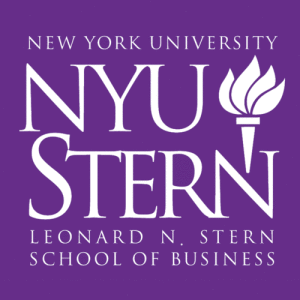 Stern Interviewed me back in December 2013. I am happy to say that I was accepted. I used Clear Admit to prepare, and it was very helpful. I felt ready and don’t remember being caught off guard by any questions. I have created a list of the most common questions you can expect during a Stern interview because I want to help all of my potential future classmates. Most Stern interviews are around 30 minutes and conducted by an admissions staff member who has read your full application. My first question was about a unique activity that I participate in that I mentioned in the application. When you arrive, you will receive a folder with information about clubs/programs you mentioned you would be interested in. You will also be given a Stern shirt so you can show your pride if you are admitted. My Stern interview was right before winter break so I didn’t hear back for almost 3 weeks, but often candidates get their decision in as little as a few days. Don’t forget to bring a copy of your transcripts, your application cannot proceed without them. I forgot mine and had to overnight them when I got back home.
Stern Interviewed me back in December 2013. I am happy to say that I was accepted. I used Clear Admit to prepare, and it was very helpful. I felt ready and don’t remember being caught off guard by any questions. I have created a list of the most common questions you can expect during a Stern interview because I want to help all of my potential future classmates. Most Stern interviews are around 30 minutes and conducted by an admissions staff member who has read your full application. My first question was about a unique activity that I participate in that I mentioned in the application. When you arrive, you will receive a folder with information about clubs/programs you mentioned you would be interested in. You will also be given a Stern shirt so you can show your pride if you are admitted. My Stern interview was right before winter break so I didn’t hear back for almost 3 weeks, but often candidates get their decision in as little as a few days. Don’t forget to bring a copy of your transcripts, your application cannot proceed without them. I forgot mine and had to overnight them when I got back home.
The Most Common Stern Interview Questions
- (63%) Why do you want to attend Stern?
- (63%) How did you come to work for XYZ company? Or why did you transition for XYZ company to ABC company?
- (53%) What is your back up plan if you don’t get a job in your desired post-MBA role?
- (42%) What programs would you get involved with at Stern?
- (37%) Describe a conflict you had at work (or challenging situation or time you failed) and how you overcame it.
- (37%) What is your proudest professional achievement?
- (37%) What companies do you want to work at post MBA? (Have a list of 5 companies and reasons for each one)
- (37%) How is your post MBA goal different from your current role?
- (32%) Where would you like to intern between your first and second year?
- (26%) How would your (friends, manager or colleague) describe you?
- (21%) What is the weakest aspect of your resume?
- (21%) If you are admitted to all of the schools you applied to, how will you decide which school to attend?
- (21%) Why do you want to get an MBA?
- (16%) How do you plan to market yourself to your target industry?
- (16%) Tell me about yourself or walk me through your resume.
- (16%) If 25 years from now you were asked to return to Stern to speak, how would you want to be introduced?
- (11%) What is your role within a team?
- (11%) What will you contribute to the class?
- What other schools are you applying to?
- What other schools did you apply to? How would you decide where to attend?
- What frustrates me the most at my current role?
- What role would I prefer to take (if any) in a student organization?
- Tell me about what you’ve learned working at your current company?
- What’s the best constructive criticism your boss has given you?
- What do you hope to learn from your future classmates?
- How did you choose to attend ABC for undergrad? What is your best memory of your time there?
- How did you first hear about Stern and in what ways did you learn about the school?
- What most surprises you about Stern?
- Is international experience important to me in my business school experience? Why?
- Tell me what you like to do in your free time.
- What do you like about New York? What neighborhoods would you consider living in?
- What would you change/enhance on the Stern website?
- What makes Stern’s culture different from other schools?
- During the first few weeks at Stern, how will you distinguish yourself from the other students?
- Why do your MBA in New York City? (about the city.. not the school)
- What do you bring to the class?
Any question that doesn’t have a percentage next to it I only saw once in interview reports. The one Stern interview question that rubs me the wrong way is the question about your back up plan. As a member of the class of 2016, I wonder is it so common that Stern students fail to get the job they want post MBA that Stern need to ask almost every student this question?
If you are invited for a Stern interview, please let me know if this guide was helpful for you. Also, check out my guide on how to prepare for an MBA interview.
Other interview preparation articles:
MIT / Sloan Interview Preparation
MBA Interview Acceptance Rate Rankings
So you have just been invited to interview at the MBA school of your dreams. Obviously this raises your chance of getting in, but by how much? In general, top ten schools have lower MBA interview acceptance rates while schools ranked 11 to 20 have a higher acceptance rate for applicants who were interviewed.
MBA Interview Acceptance Rate by Rank
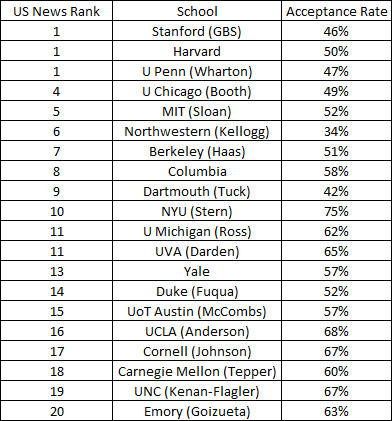
Interview acceptance rate for Stanford, Harvard, Wharton, Booth, MIT, Kellogg, Hass, Columbia, Dartmouth, NYU, Ross, Darden, Yale, Duke, McCombs, Anderson, Cornell, Tepper, Kenan-Flagler, Emory
The acceptance rate ranges from 34% to 75% for schools in the top 20. The average MBA interview acceptance rate for the top 10 is 50% and it is 62% for schools ranked 11 to 20.
MBA Interview Acceptance Rate Rankings from Highest to Lowest
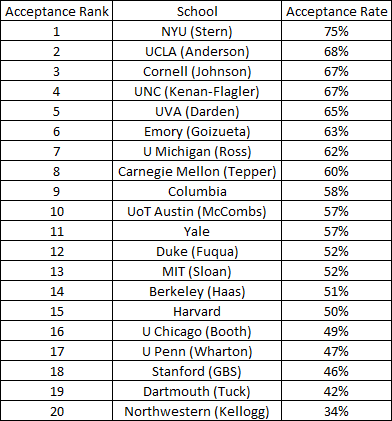 NYU jumps out as the highest acceptance rate by a wide margin. If you have been selected to interview at Stern then you can prepare to open a bottle of champagne because you are probably going to business school. No other school in the top 10 has an interview acceptance rate above 60%.
NYU jumps out as the highest acceptance rate by a wide margin. If you have been selected to interview at Stern then you can prepare to open a bottle of champagne because you are probably going to business school. No other school in the top 10 has an interview acceptance rate above 60%.
On the other end of the spectrum is Kellogg and Tuck with the lowest acceptance rates. These two schools will allow anyone who visits campus to interview, so it is not surprising that they admit significantly fewer applicants who are interviewed. Most of the top 10 schools have an acceptance rate clustered between 46% and 51%.
Duke has the lowest acceptance rate for a school not in the top 10 at 52%. The rest of the schools range from 57% to 68%,
Good luck and don’t forget to prepare for your MBA interviews!
Stern Interview Acceptance Rate Analysis
I know that the final decisions for applicants who were interviewed for New York University’s business school are expected soon. I decided to perform a Stern interview acceptance rate analysis to see if I could predict the chance of acceptance for applicants who were invited to interview. From my data sample 74% of applicants who were invited to interview were ultimately accepted.
Stern Interview Acceptance Rate by GMAT
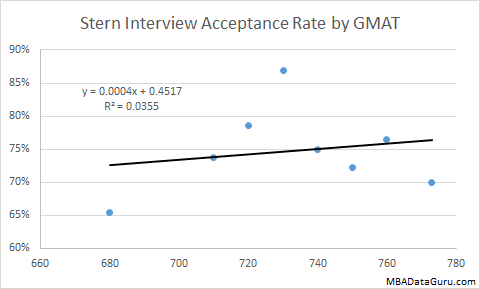 Not only is the slope of the regression line very flat, but also the the R-squared is only 3%. These two pieces of information suggest that once a candidate is invited to interview, their GMAT has no impact on acceptance rate.
Not only is the slope of the regression line very flat, but also the the R-squared is only 3%. These two pieces of information suggest that once a candidate is invited to interview, their GMAT has no impact on acceptance rate.
Stern Interview Acceptance Rate by GPA
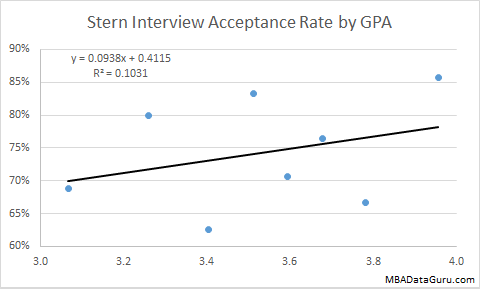 The slope of the GPA graph is a little steeper than the GMAT graph slope. The R-squared is also higher, coming in at 10%. Once again, this indicates that GPA has a little more impact on your chance of admission after being invited to interview compared to GMAT.
The slope of the GPA graph is a little steeper than the GMAT graph slope. The R-squared is also higher, coming in at 10%. Once again, this indicates that GPA has a little more impact on your chance of admission after being invited to interview compared to GMAT.
The low R-squared of the GPA and GMAT compared to admissions for interviewed applicants suggest that NYU treats all applicants as equal once they are invited to interview. If interviewed you are on equal footing compared to all other candidates invited to interview. This is different compared to Ross, which has a much higher correlation between GMAT / GPA and acceptance rate. The GMAT & GPA acceptance rate R-squared ranged from 30% to 75% for Ross, which is much higher than the 3% to 10% for Stern.
The data used for this post comes from GMAT Club.
Stern Acceptance Rate Analysis
I just finished building the Stern acceptance rate prediction model. I will post the admissions calculator as soon as I have time to finish learning PHP and then build that portion of the website. I’ll probably have time to work on it over Christmas break, but right now I am too busy applying for interviews for summer internships. In the mean time I will share some of the insights I got from building the model.
Stern Acceptance Rate by GMAT
The first thing that jumped out at me was that the acceptance rates I came up with are noticeably higher than the published acceptance rate of 15%. I believe that this is because the average candidate who applies and posts their data on GMAT Club, where I get my data, is more competitive than the average candidate. The average GMAT Club applicant to Stern has a GPA or 3.45 and GMAT of 709, which is not too far from the scores listed on the class profile for Sterns class of 2016 of 3.52 and 721.
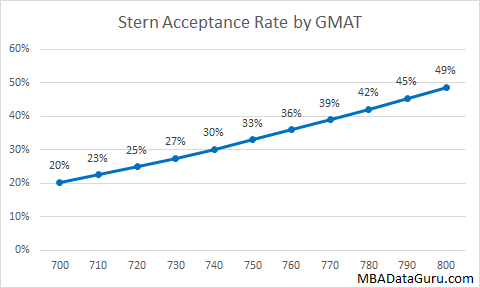 If you are applying to Stern, it is pretty obvious that having a higher GMAT is important and will significantly raise your chances of being admitted. To create the graph above, I used my model with the average GPA of 3.45.
If you are applying to Stern, it is pretty obvious that having a higher GMAT is important and will significantly raise your chances of being admitted. To create the graph above, I used my model with the average GPA of 3.45.
Stern Acceptance Rate by GPA
Next I looked at how GPA affects Stern acceptance rate. Once again there is a clear relationship between GPA and admission rate for NYU. In the graph below I used the average GPA score of 709 in my admissions model.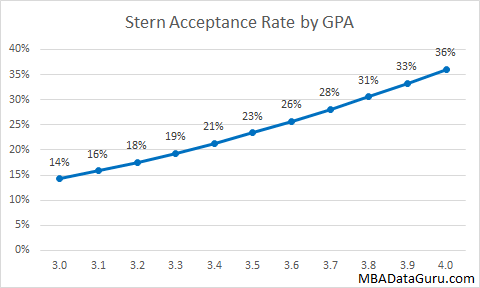
Stern Acceptance Rate by Round
Many candidates want to know if it matters in which round you apply. I took a look at the raw acceptance rate by round for NYU. As you can see the acceptance rate for round 2 is slightly lower and for round 3 it is noticeably lower.
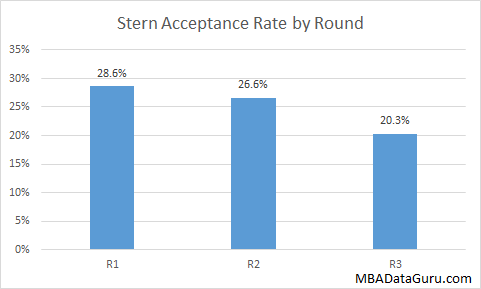 The acceptance rates above are raw numbers, not the predicted values from my admissions model. Why you ask? Because when I took into account all of the other factors, the round you apply in is not statistically significant. The reason the acceptance rate is lower in round 2 and 3 is not because the schools are more selective but because on average lower quality candidates apply in those rounds. If you are a qualified candidate, do not worry about applying to Stern in round 3, you still have a good chance of getting in.
The acceptance rates above are raw numbers, not the predicted values from my admissions model. Why you ask? Because when I took into account all of the other factors, the round you apply in is not statistically significant. The reason the acceptance rate is lower in round 2 and 3 is not because the schools are more selective but because on average lower quality candidates apply in those rounds. If you are a qualified candidate, do not worry about applying to Stern in round 3, you still have a good chance of getting in.
Stern Prefers GMAT over GPA
In the past I tried to figure out if Stern prefers a high GMAT or GPA and didn’t come up with anything conclusive. Now that I have built the Stern admissions model I can see how a similar change in GMAT or GPA impact acceptance rate at Stern. In the graph below I compare how much the admissions rate changes if I alter the GMAT or GPA by a standard deviation. If you are applying to business school then you should probably know what a standard deviation is, however if you don’t it is a standard measure of variance in a population or sample. Since I can’t compare an absolute variance because GMAT and GPA are on different scales, I compare how the shift of one standard deviation impacts the Stern acceptance rate.
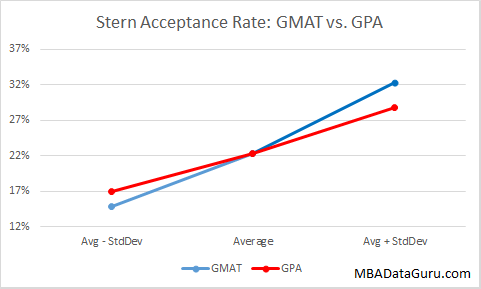 In the graph above, you can see that increasing the GPA by one standard deviation (.28) increase acceptance rate by 29%, but raising the GMAT score by one standard deviation (39) leads to a 45% higher chance of admissions. It is clear that Stern prefers candidates with high GMAT score over ones with a high GPA. This is good news for candidates with a low GPA because with enough hard work, you can increase your odds significantly by raising your GMAT.
In the graph above, you can see that increasing the GPA by one standard deviation (.28) increase acceptance rate by 29%, but raising the GMAT score by one standard deviation (39) leads to a 45% higher chance of admissions. It is clear that Stern prefers candidates with high GMAT score over ones with a high GPA. This is good news for candidates with a low GPA because with enough hard work, you can increase your odds significantly by raising your GMAT.
Other NYU Admissions Insights
I also found that NYU prefers candidates with an average age of 27 to 28, the further you are from this average age, the lower your chance of getting in. Stern really likes candidates that come from consulting. Applicants from consulting had a acceptance rate of 42% vs. 21% for non-consultants. Having more work experience also increased your odds of admissions. Acceptance rate increased by about 2% for each year of work experience. However, once you pass 28, the age deviation factor is significantly stronger than the work experience factor so you shouldn’t wait until after 28 to apply.
I noticed that candidates that majored in business or engineering had a lower chance of admission. Business majors with average scores had a 8% chance of admission compared to 24% for non-business majors. Engineers had a 13% chance of getting in compared to a 26% chance for non-engineers. These differences are statistically significant even after taking into account all other factors. That being said, I majored in engineering and I got into Stern. I also know many other business and engineering majors who are currently attending Stern with me.
Stern: How Important is the GMAT vs. GPA
I posted an updated analysis of Stern Acceptance rate for GPA vs. GMAT on this page.
NYU is currently ranked 10th by US News and World Report for full-time MBA programs and is tied for the 3rd highest average GMAT score. I expected to see Stern prefer GMAT over GPA, but that is not what I found.
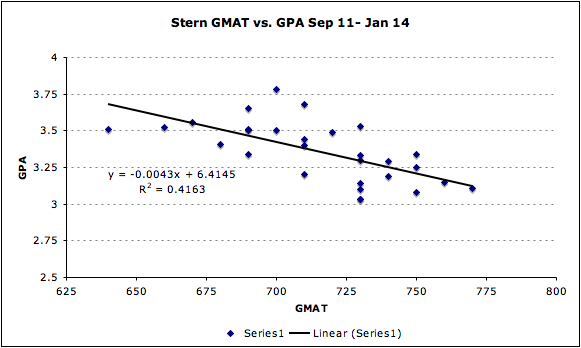
It turns out that Stern has by far the smallest slope of any of the other schools I have looked at so far. The .0043 slope means that Stern would view a candidate with a 800 GMAT and 3.00 GPA similarly to one with a 700 GMAT and 3.43 GPA.
Other Schools:
Methodology: The scatterplot represents the 50% of applicants who are accepted with the lowest GMAT and GPA. It isn’t helpful to look at the top 50% of applicants because those are not the marginal candidates who barely got in. I occasionally will remove very low outliers because those candidates may have been admitted due to very strong connections that most applicants don’t have. I never remove more than 5% of the total accepted students as outliers. The slope of the scatterplot demonstrates the point at which the school is indifferent to GMAT vs. GPA.

